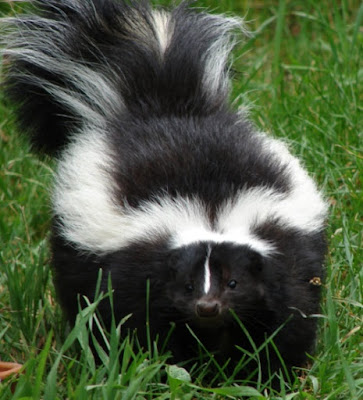Skunks in the Works
A long, long, time ago in a small town far, far away (northern Michigan), I was spending a weekend alone at my grandmother's old house. There was a wooded area behind the place. Being alone and getting bored, I took an evening stroll. Motion near the base of a shed caught my attention. I moved closer and realized that the black and white kitties were actually skunks — mom and the young 'uns. They were facing away from me, with their tails up. I knew enough to take the warning, and backed away.
Skunks are ubiquitous in the continental United States, (not to be confused with Skunk Works) and some species have a wide range in North America. Some folks call them polecats, but that is a misnomer, since the European polecat is related to the weasel, and the skunk has a more distant relation. They don't even send each other Christmas cards. European polecats and skunks both manage to make a stink.
Although they burrow, skunks are opportunists, and can live in hollow logs, under your front porch, in the shed, on anti-creationist forums, and other places. This can make for startling encounters if you're in the wrong place at the wrong time. They are actually rather intelligent, and some people have them as pets. It would be fun to be taking the skunk for a walk down the street, but it's illegal to own one here in the state of New York, as it is in many states.
via GIPHY
People may be disgusted by the malodorous critters, but they actually provide a service by eating vermin that cause disease. They have excellent night vision, an excellent sense of smell, and that well-developed defense system. Skunks have many features showing that they were designed by the Master Engineer.
 |
| Credit: Pixabay / Torli Roberts |
Although they burrow, skunks are opportunists, and can live in hollow logs, under your front porch, in the shed, on anti-creationist forums, and other places. This can make for startling encounters if you're in the wrong place at the wrong time. They are actually rather intelligent, and some people have them as pets. It would be fun to be taking the skunk for a walk down the street, but it's illegal to own one here in the state of New York, as it is in many states.
via GIPHY
People may be disgusted by the malodorous critters, but they actually provide a service by eating vermin that cause disease. They have excellent night vision, an excellent sense of smell, and that well-developed defense system. Skunks have many features showing that they were designed by the Master Engineer.
Mephitis mephitis means, appropriately enough, ‘a noxious exhalation from the ground’. This skunk is known for its two broad stripes on the back, meeting at the head, and a white stripe down the centre of the face. I’ve also seen versions that are almost all white or all black. Their claws are not retractable and make great tools for digging. It’s just as well because our Creator has made them a ground creature. The Eastern Spotted skunk, Spilogale putorius, has irregular stripes and elongated spots on the sides. It is also faster, more agile and more of a tree climber. Both live in dens, either found abandoned or dug themselves on well-drained sites. The spotted skunk, being the more social, has been found with 12 individuals in one winter den.To read the entire article, click on "Lasting impressions". You can also listen to a typical skunk sound in the very short video below.